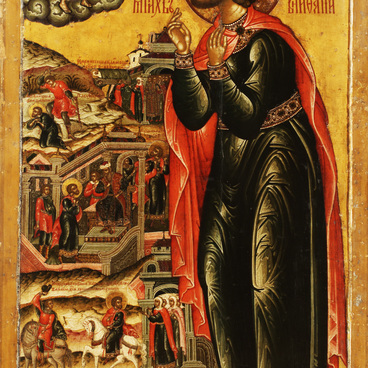The Great Martyr George is one of the most revered saint warriors in Rus. On the icon from the collection of Yaroslavl museum-reserve, he is depicted as a doughty warrior. In his right hand, George holds a silver cross, which is an attribute of a martyr. In his left hand, there is a spear on a thin shaft and a sword in a sheaf. A bow and a quiver with arrows lies at his feet. The Saint was regarded as the patron of konungs (lords) and ordinary soldiers. In folklore George was personified with a Russian epic hero Egoriy the Brave.
Saint George in Acts
Время создания
End of 17th century
Размер
142,5x104,5 cm
142,5х104,5 cm
142,5х104,5 cm
Техника
Tempera
Коллекция
Выставка
3
Открыть в приложении#1
Unknown author
Saint George in Acts
#4
#5
The icon was created under the influence of the Baroque style: strong colors, thin ornament on gold armors and the master’s attention to details. Figures of the Saint and other persons on the icon have some mannerism in their poses and gestures
#6
Acts of the Saint specifies that he was from a noble kin from one of the regions in Asia Minor. At the times of persecutions of Christians St. George publicly condemned executions and called himself a Christian. In 303 by the orders of the Roman Emperor, he was tortured for his refusal to repudiate Jesus Christ. The Saint was stabbed by spears and poisoned, his bones were crushed but he remained in a whole skin. After tortures he was beheaded.
#7
The painting’s composition is traditional for hagiographical icons. Life of St. George from his birth and to his death is depicted in 16 border scenes around the central part of the icon (centerpiece). Each border scene has several hagiographical stories. Most of them are dedicated to his martyric death while two miniature pictures tell about the miracles referred to the Saint by the religious after his death.
One of the border scenes features the most famous miracle – St. George Slaying the Dragon. According to the legend, the Dragon lived in a lake near one of cities in the Lebanese mountains. Citizens had to send young men and women to be devoured by the Dragon. St. George prayed and killed the Dragon. Many citizens saw the miracle, received baptism and became Christians.
#8
The last border scene features a rare subject of St. George Saving the Young Man from Prison. The Hagarenes (an old name for the Arabs) destroyed a church, killed and imprisoned the locals on the Milytin Island. Among the imprisoned there was the son of a parishioner who sacrificed abundant offerings to the church together with her husband. One day the woman was praying before the icon of St. George when suddenly her son emerged. He told her that an equestrian on a white horse saved him.
#9
Among the subjects of the scenes, there is also the Coronation of the Virgin. It was particularly popular in the 18th century when the Russian Empresses were in power.
#10
Yaroslavl Museum Reserve
читать дальшескрыть
00:00
00:00
1x
Saint George in Acts
Время создания
End of 17th century
Размер
142,5x104,5 cm
142,5х104,5 cm
142,5х104,5 cm
Техника
Tempera
Коллекция
Выставка
3
Открыть в приложении
Поделиться



